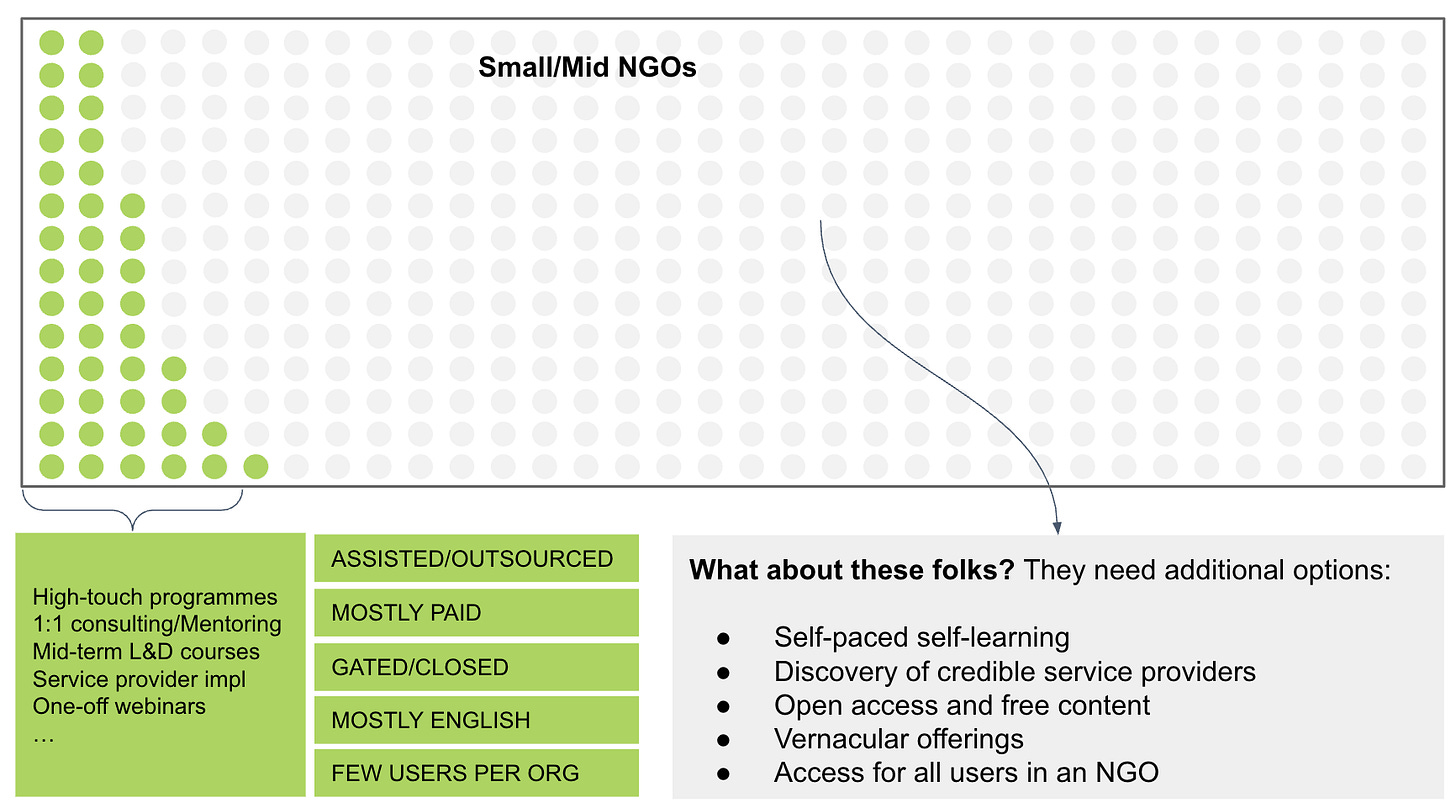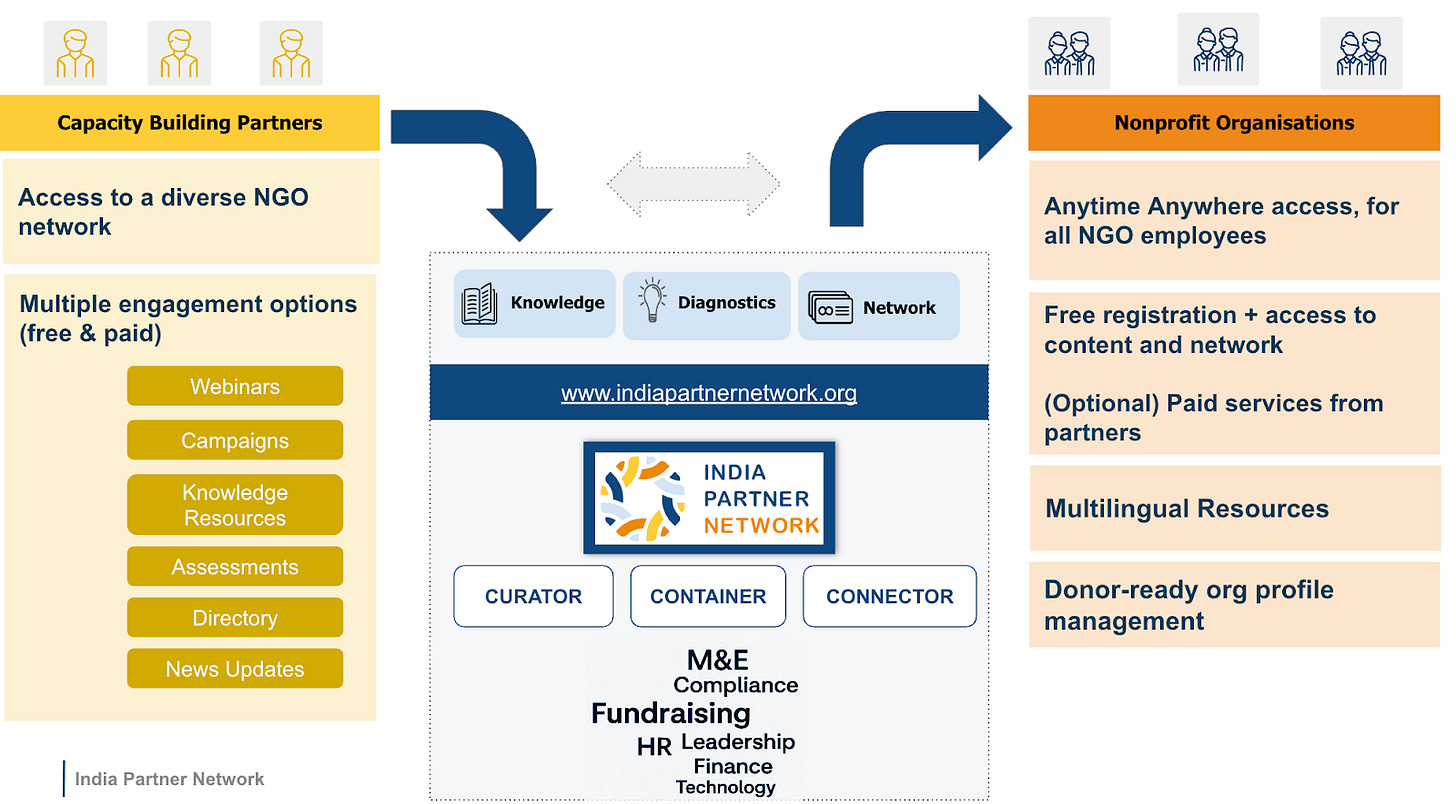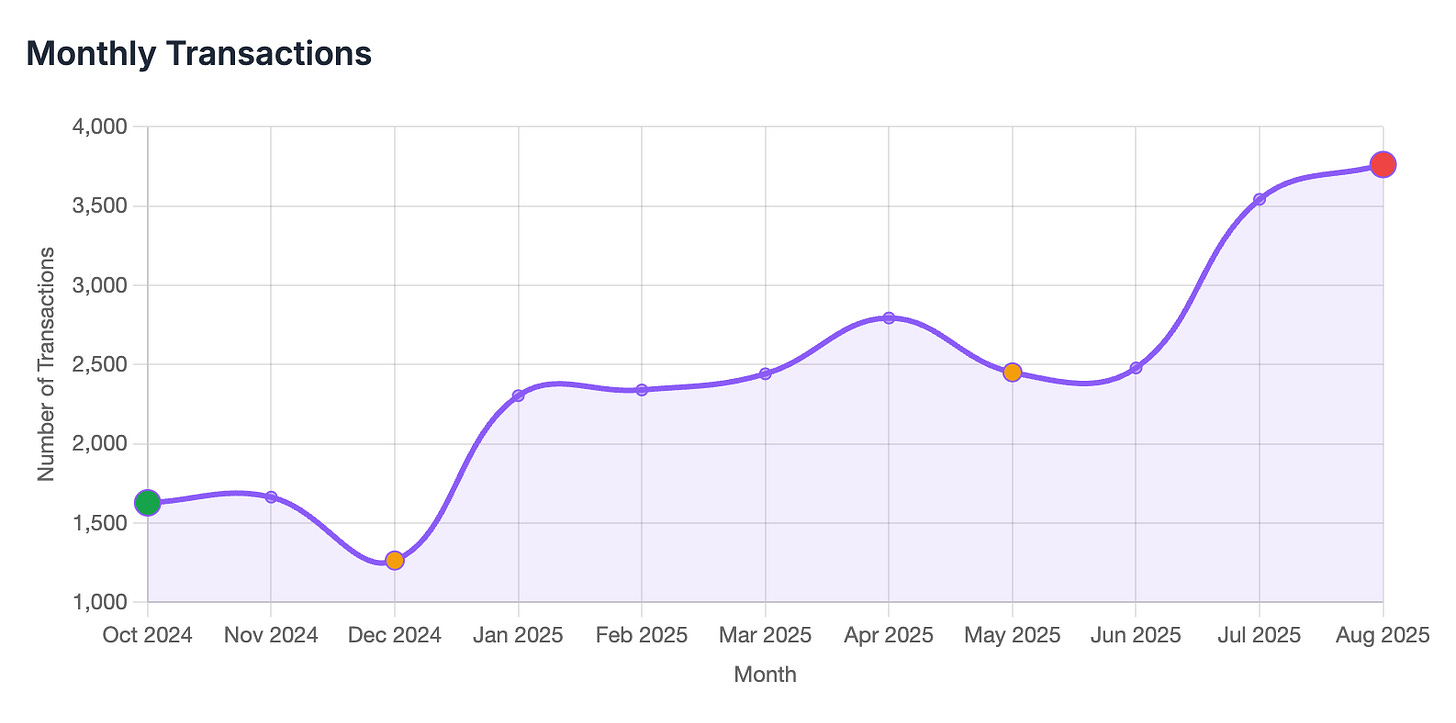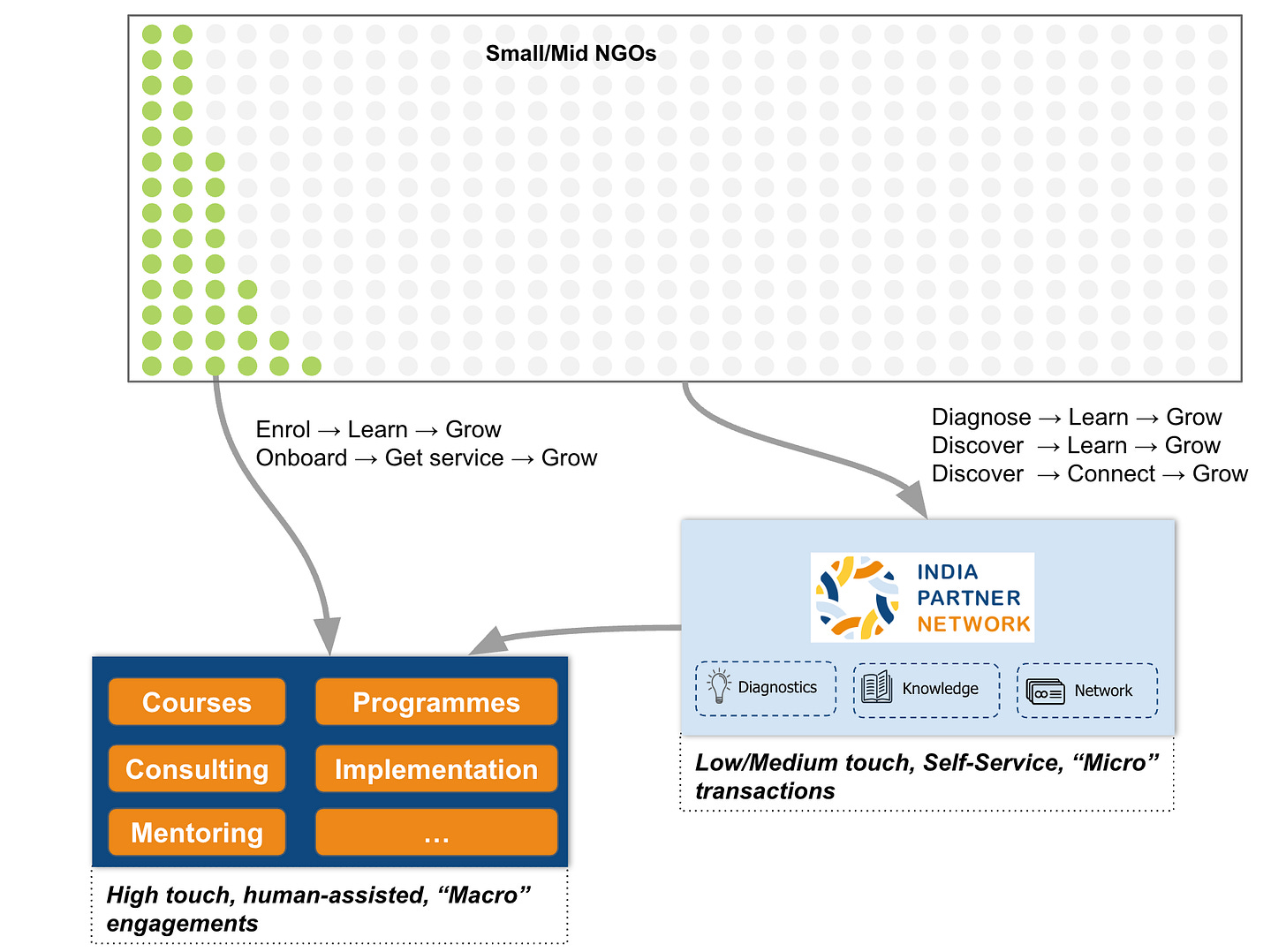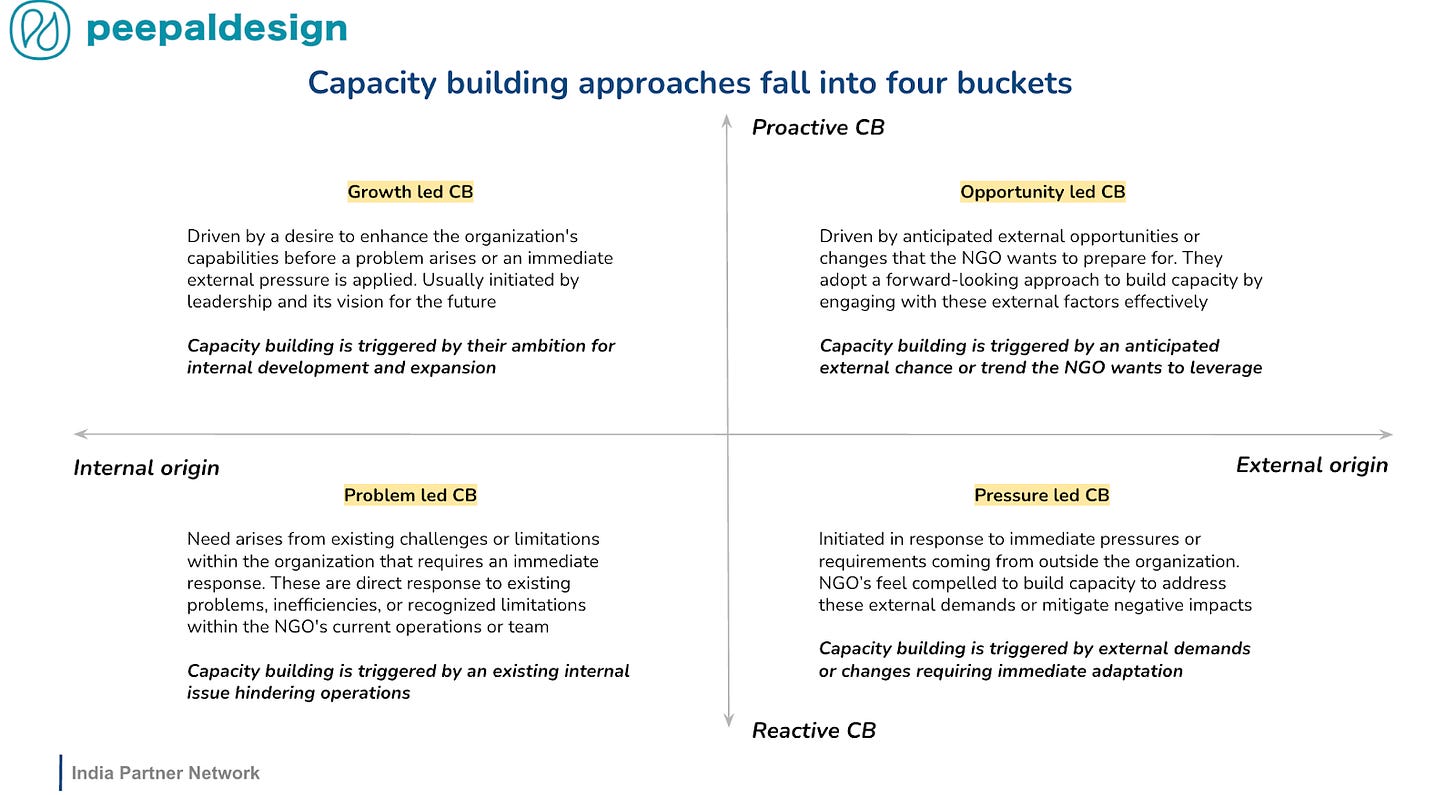IPN is 2 years old
Where are we now, and what have we learned?
Tens of thousands of nonprofits in India have very limited access to solutions for their organisation development needs. This is changing now.
The idea for a digital platform like India Partner Network (IPN) was seeded, about three years ago, by evidence gathered from data and research, and a hypothesis based on this evidence.
We’d seen data that highlighted how small-medium nonprofits in India struggled to grow and absorb philanthropic capital flowing into the sector [1]. This shortcoming among NGOs stemmed mostly from gaps in their own organisational development. Capital was a key constraint for these NGOs, as donors largely funded social impact programs, not org capacity development [2]. But our market research also revealed that existing capacity building options – either high-touch programmes, or websites with fragmented offerings – did not address the scale of the problem. Tens of thousands of nonprofits in India had very limited access to solutions for their organisation development needs.
Our hypothesis was that a self-service multi-lingual digital platform dedicated to nonprofit capacity building would fill this gap, complementing existing solution providers and reaching a large segment of small to medium-sized nonprofits.
Three years on, new data has strengthened earlier evidence [3] [4], and our hypothesis has proven right in ways we could not have imagined [5] [6]. Along the way, we’ve also learned about the challenges with this approach.
The big picture – two years after IPN’s launch
IPN launched two years ago, in August 2023. Since then:
3000+ nonprofits have registered on the platform, forming a diverse, pan-India group.
Over 4000 users across these nonprofits have engaged with the various self-service solutions the platform provides: Knowledge Resources, Webinars & Masterclasses, Campaigns, Assessments, Directory, and the donor-ready Profile.
IPN today offers 280+ knowledge resources in 4 languages (English, Hindi, Kannada and Tamil) which have been viewed over 11000 times.
Over 300 nonprofits have taken close to 400 assessments to determine their current maturity levels in Fundraising and M&E.
We have run 100+ capacity-building-related Webinars/Masterclasses/Campaigns from ~50 partners. These events and campaigns have attracted 5000+ registrations and received an average rating of 4.1 out of 5.
The recently-launched Directory lists 50+ service providers. So far ~70 connection requests have been sent from NGOs to a subset of these providers.
And we’ve shared 500+ capacity-building-related news items from the ecosystem, which have received about 50 clicks on an average.
What do these numbers signify? How well is this self-service multi-lingual digital-platform model working? What are our goals and where are we on this journey?
A micro-transactions approach
IPN is not opinionated about the way nonprofits must build capacity: users choose the option on IPN that best meets their needs.
One type of nonprofit may wish to follow a structured, mid-term plan: for instance, to improve their M&E readiness in the next 6 months, starting with an assessment and following the score-based recommendations. Another may want to up-skill their team in an upcoming area of interest, through a webinar on AI or the new DPDP law. Yet another may seek guidance from an external consultant on how to draft proposals better, or register for a programme to improve their digital marketing function. And there may be those whose curiosity is triggered by an item in IPN’s weekly news digest notification.
We track such user actions as “value transactions” on IPN. The “value” here has a micro character, and our thesis is that engaging in many such micro-transactions is a good way for NGOs to approach capacity building. And that this approach often complements the high-touch (macro) capacity building programmes that run for several months1.
We now have growing evidence that gives credence to this micro-transactions thesis. Engagement data on such transactions – the most important metric we track – has been growing steadily in tandem with user adoption:
On an average, each month 20% of total IPN users have been engaging in these transactions2.
Further, qualitative feedback from users – an equally important measure – reveals that they really appreciate this one-stop shop where, depending on their need, they can pick and choose the option that fits best.
“For grassroots civil society organizations like ours, which often struggle with limited resources, this platform has been a game-changer. It offers a ready-made solution that enables us to develop essential tools and reinforce our internal systems without having to invest heavily in developing these resources ourselves.” (Navprabhat, Executive Director, Mountain Valley Development Association)“I treat IPN as the first stop for building my and my team's capacity, developing my perspective on ecosystem trends by reading curated articles of news & updates, and keeping the Org profile updated for branding and funding opportunities.” (Nikhil, Founder, Upkram Educational Foundation)
“As a small organization based in a remote location, having access to the right resources and support is crucial for our success. Before discovering IPN, we often struggled to find the right resources, or keep up with the latest information and opportunities. Now, logging into IPN every week has become a ritual for us.” (Adv. Kaivalya Rajaram Dandekar, President and Managing Trustee, Lokmanya Public Charitable Trust)
Read more user testimonials here.
Why do these nonprofits like the IPN approach to capacity building? The reason is not hard to grasp. The time these nonprofit leaders need for organisational development competes with the time they must devote to their core mission. Given this constraint, even leaders keen on capacity building prefer the flexibility of taking up small offerings – micro transactions – that can be consumed on-demand3.
Perhaps the most compelling evidence has come from the aggregated data of hundreds of nonprofits users who engage in capacity building via IPN, regularly and voluntarily – that is, without any push from donors. Nonprofits on IPN have cumulatively completed over 30,000 micro-transactions so far.
Let’s reflect on this a bit.
Here is evidence that nonprofits not only want to build institutional capacity and improve their resilience, but are also acting on this intent without a push from donors or a capacity building intermediary (which typically happens in the context of a donor-funded programme run by an intermediary). And they are doing it regularly, on a continuous basis.
This argument is strongly supported by the Net Promoter Score of 54 (which is a really good score!) we received from our first NPS survey in July-August 2025. The optional feedback remarks from our “promoters” (70% of the respondents) indicates how strongly these users feel about having access to a platform like IPN [6].
Given the scale IPN is targeting4, the group of nonprofits who engage proactively in capacity building is still a minority. But early feedback from this cohort reveals something important:
IPN’s self-service digital platform approach, coupled with micro-transactions, works really well for nonprofits who are keen on capacity building but cannot always engage in a high-touch programme (due to time and resource constraints).
In tech/product parlance, IPN has now crossed the Problem-Solution-Fit stage. Which means there is a clear alignment between an identified “customer” problem and the solution being offered to address it. Our goal now is to achieve Product-Market-Fit by expanding consistent usage of IPN by the broader “market” of small-medium nonprofits.
The philosophy of curation (And why we are cautious about AI)
Early in our journey, in one of the meetings where IPN was being presented to an external stakeholder, someone asked: “How does IPN sit next to the already existing capacity building solutions out there? Are you competitors? Do you partner with some of them?”
Our immediate response was that (a) through our on-demand and self-service approach we complement the existing high-touch capacity building providers who offer courses and programmes, and (b) as a platform we connect the supply from these providers to the demand from NGOs.
A salient aspect here is how we do this.
IPN is not an aggregator platform: it offers a curated collection of best-in-class solutions and solution providers. We take the time to research, collect, review, and publish “content”: knowledge resources, webinars, masterclasses, service providers, news items, etc. Content that matches our guiding principles, like prioritising practice and action-orientation over theory, targeting needs of small-medium non-profits over large ones, considering vernacular and regional geography related needs, among others. Further, we have well-defined processes that govern how we onboard or link to new “content” (including service provider entities) on the platform, and how often we revisit and review old content.
Content on the internet is already a commodity, and NGO capacity building content is no exception. AI today is accelerating this trend. In this environment, where users feel overwhelmed by the available choices, getting access to curated content from a trusted advisor is what nonprofit users need: this is what defines IPN’s stance on how we surface content to NGO users.
So instead of exposing NGO users directly to the output of Gen AI tools, we’ve chosen to first act as the expert in the middle and share only vetted content, like AI-generated video translations whose scripts are edited by the IPN team. The Gen AI bot use-case will need — in comparison — a lot more effort and cost to validate and monitor results for a general audience, and it currently is not high on our list of priorities5.
The magic of connections
Earlier this year, in an IPN webinar with speakers from Project Tech4Dev and Center for Mental Health Law and Policy, Sonali from the CMHLP spoke about how they discovered Tech4Dev’s Fractional CxO program via IPN. Following this discovery, they went on to onboard a Fractional CTO into their organisation, and now, a year later, they were co-presenting on IPN the results of this collaboration.
The circle was complete: we couldn’t have scripted a better narrative.
Another user, Kaivalya Dandekar, President and Managing Trustee of Loksadhana, shared with us that “Through IPN, we discovered and successfully participated in the SVP Fast Pitch and NSRCEL’s incubation program.“
The beauty of digital platforms is that they enable connections and synergies that may not have been imagined by its creators. Such platforms simply facilitate connections, matching relevant demand to credible suppliers. When this works the result is a win-win for both, and it also triggers a feedback loop that leads to more connections. The network grows stronger, and the overall ecosystem is the biggest beneficiary.
IPN offers multiple pathways for discovery and connection6. The IPN Directory, in particular, addresses the well-known problem of discovering credible partners. In the words of Subramanya Shastry, Consultant Media and New Initiatives, Agastya International Foundation:
"We recently used the IPN directory while doing an impact assessment for a program run by Agastya International Foundation, and it was such a great resource. Finding the right vendors for social impact work is usually difficult. The directory made it simple to connect with trusted vendors quickly, and it saved us a lot of time. Honestly, it’s the kind of resource the sector has needed for a long time."
Currently there are 100+ connection options (for nonprofits) waiting to be discovered on IPN. We plan to expand this further by onboarding providers from regional (tier 2 and tier 3) areas and with more vernacular options.
Current challenges, Audacious goals
Earlier this year, the results of a user-research we conducted via Peepal Design gave us insights into the NGO-leader mindsets towards capacity building:
Reflecting over this in an earlier blog post, we’d written: “Most NGO capacity building today is problem-led or pressure-driven — rooted in immediate needs, not long-term vision. This highlights a critical opportunity for platforms like IPN: to both support reactive needs and to move NGOs from reactive to proactive capacity building.”
Targeting this behaviour change (from a reactive to a proactive approach to capacity building) is an audacious goal, and it requires an ecosystem-wide effort. At IPN, beyond all the platform specific offerings and nudges, we’ve also been engaged in creating more awareness on capacity building and its benefits, amplifying the efforts from other players keen on furthering the NGO capacity building agenda [3] [4].
We’d known about this challenge early on, but in the last year we’ve learned about another one: Nonprofit users typically find it hard to navigate and effectively use a self-service digital platform. This is reflected in current behaviour patterns we’ve seen:
Most IPN users currently tend to engage with only one or two offerings on IPN – they do not explore other IPN solutions they can benefit from. Further, we’ve struggled to get users engage on a structured journey, like systematically following the recommendations generated after an organisation assessment.
This is a challenge and an opportunity. Through our digital platform model we have an opportunity to guide users to improve their skills on this front. No one knew much about social media marketing until the rise of platforms like Facebook and LinkedIn. This skill then emerged from repeated use of such platforms. The question we are asking ourselves is this: can we teach nonprofit users the skill to use – in a self-directed manner – a digital platform to meet their capacity building needs? Early experiments (like cross-positioning of related solutions, cohort-specific notifications) have shown promise.
These are early days – we still have a long way to go. But this digital self-sufficiency is both a prerequisite (to achieve the goal of capacity building mindset change) and a foundation upon which nonprofits can grow without always depending on external assistance. Hence this will remain a priority for us in the years ahead.
Data and insights for the ecosystem
By facilitating transactions, platforms also generate data about demand and supply. This data can reveal insights relevant for the broader ecosystem. With IPN, we see this facet emerging in multiple dimensions: basic compliance data from nonprofits who complete their IPN profile, usage data based on registrations/views/connections triggered by nonprofit users, and data on OD-area readiness (like Fundraising readiness or M&E readiness) we receive when nonprofits take an assessment.
Aggregated data from IPN Assessments can reveal a lot about the organisational maturity of the nonprofit sector. Here’s a sprinkling of these nuggets (taken from our sample of ~300 nonprofits who have completed the assessments so far):
Only 30% of nonprofits have a funder-renewal rate of 50% or higher.
Only 7% of nonprofits engage with retail donors. This number goes down to 5% for nonprofits with less than 2 Cr Annual Budget.
40% of nonprofits use Pen-Paper or Excel for data collection.
30% of nonprofits have no Theory of Change defined.
IPN currently offers assessments on fundraising readiness and M&E readiness. A marketing and communications readiness assessment is underway. Compliance will follow after that. Our aim is to publish a “State of Sector” report on capacity building each year. We hope this year-on-year exercise will also reveal trends around what’s working and where gaps still persist.
An Ecosystem Initiative, not another silo
India Partner Network, at 2, is still a toddler. We’ve just learned to walk, and along the way we’ve acquired a few ardent followers.
We now understand a little about what works with such a self-service-multi-lingual-digital-platform-micro-transactions-curator-connector model. And the challenges and opportunities that lie ahead if we pursue this approach.
Two-sided platforms can be tricky to incubate. How to generate demand when there is limited supply? And how to incentivize “suppliers” to participate when there is hardly any demand? We’ve now passed this barrier: two years after IPN’s launch, there is enough demand from nonprofits to spark interest from the supply side of the equation.
This supply-side, our IPN partners (capacity building intermediaries, service providers, NGO networks, and Donor networks), will continue to be an important success factor in the years to come. Without them, IPN regresses into yet another offering nonprofits have to choose from; with them, IPN can become the single portal NGOs use to discover and connect with relevant solutions and solution providers in the ecosystem. In the words we’ve heard from several of our NGO users: “The one-stop shop for everything related to nonprofit capacity building.”
When this works, it will be a win for all stakeholders keen on nonprofit capacity building: NGOs, NGO Networks, Donors, and Capacity Building Intermediaries. Together, such a network can transform this ecosystem.
Manohar Sreekanth
Partner & CTO, Sattva Consulting
Sources:
[1] The sorry state of Fundraising in Indian NGOs
[2] Time for new funding practices
[3] Strategic Investments: Fueling NGO Fundraising Success and Resilience
[4] Case Studies in Nonprofit Capacity Building
[5] IPN 2nd Anniversary Report
[6] IPN Testimonials
Several active IPN users we’ve spoken to are ones who’ve graduated from programs like Dhwani Foundation’s Niranthara, or Atma’s FOI. For them, IPN is a way to stay engaged with this theme, because capacity building is a continuous process, not a 0 to 1 switch.
Given the occasional (and on-demand) nature of these use-cases, this is a reasonable percentage. Not everyone would be engaging on capacity building on a regular basis.
This is not IPN’s discovery. The sector has been offering byte-sized learning through webinars for a long time now. What IPN has done is apply this approach to other capacity building areas, like assessments, knowledge resources, news bytes, etc, using it as guiding principle for all types of capacity building.
We aim to reach 30,000 nonprofits by 2030.
In the mid-term this use-case (of asking a bot for short answers to capacity building queries) is best served directly by Gen AI tools like ChatGPT or Perplexity. Our efforts therefore is to focus on SEO and GEO techniques so that the best content on IPN is used by these Gen AI tools in their responses.
NGOs can search for a provider in the IPN Directory, receive specific provider recommendations from IPN Assessment results, register for an event or campaign from a broad spectrum of organisations and experts, and discover ecosystem-wide opportunities in the weekly IPN News & Updates digest.



